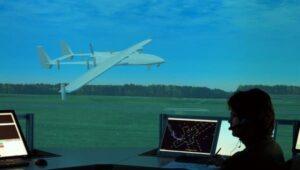Reliably monitoring extensive areas of the sea is a major challenge for the coastguard and emergency relief services. Unmanned aircraft are expected to make a critical contribution to this in the future. In December 2012, the German Aerospace Center (Deutsches Zentrum für Luft- und Raumfahrt; DLR) simulated experimental unmanned flights over the Mediterranean. The virtual test flights showed that the interaction with regular air traffic would work properly. They are preparing for the first remotely controlled test flights around the southern Spanish city of Murcia in the summer of 2013.
“Real time images from the air are a key for generating maritime survey images,” says Dennis Göge, safety research programme coordinator at DLR. “Today, aerial photographs are almost exclusively taken using manned aircraft. We are working with our partners in the Desire Project to enable unmanned aircraft to be used over the open sea as well in future. In this way, we can make a contribution to increasing maritime safety.” Desire (Demonstration of Satellites Enabling the Insertion of Remotely Piloted Aircraft Systems in Europe) is an ESA project aimed at testing satellite-supported guidance of unmanned aircraft in coastal regions and over the sea.
Detailed maritime monitoring
“The simulation shows that unmanned aircraft can be slotted in among controlled civilian air traffic,” says department head Achim Friedl, from the Federal Ministry of the Interior, who is responsible for Federal Police Force Technology and Logistics. He learned about the DLR simulation campaign on site. “The use of unmanned aircraft would be an enhancement to the patrol boats and helicopters we use today for the tasks carried out by the Federal Police Force on the North Sea and Baltic Sea.” Detailed monitoring of the seas is important for getting help to the right place at the right time. For example, it is quicker to find shipwreck survivors from the air. And maritime protection would benefit from the discovery of illegal oil dumping.
Satellite-supported communication is essential for using unmanned aircraft to capture images over the sea. The advantage of aircraft with in-built sensors over sensor-bearing satellites that they can continually deliver detailed, up-to-date information of a region. As they operate over the sea out of direct sight, they need a data connection via satellite to pilots in the ground control station. This enables reliable communication and control.
Virtual testing of the initial flight
DLR has used the simulation campaign to prepare for the initial satellite-supported flight of an unmanned aircraft in Murcia. In doing so, the scientists used their broad expertise in virtual analysis of European air traffic. “We must make sure that testing the remote controlled aircraft does not compromise regular air traffic in any way,” says Dirk-Roger Schmitt from the DLR Institute of Flight Guidance. “The interaction between the air traffic controllers in the tower and the pilots on the ground must work. We were able to demonstrate this in the enclosed virtual test run.” The project consortium has to demonstrate a faultless flight to the Spanish air traffic authorities first to get approval for the initial flight. The simulation campaign serves as the basis for this.
For the campaign, air traffic controllers and a pilot for unmanned aircraft systems were on site in the validation centre at the Institute of Flight Guidance. Air traffic control workstations and the ground station for the aircraft were set up, as were workstations for the pilots of the other aircraft sharing the air space with the unmanned aircraft during the simulation. The actors played out the remote controlled flights as they would in reality. They communicated via a radio connection while the aircraft was connected to the ground station via a simulated data link. For example, the aircraft took off from a virtual runway at San Javier Airport in Murcia, then flew east towards the Mediterranean to locate shipwreck survivors in accordance with a predetermined flight plan and – a few mouse clicks later – finally turned back to land automatically. The virtual flights were undertaken in various air traffic, weather and communication conditions. For example, the scientists investigated how the time delay in the signal transfer via satellite affects the flight in controlled air space. In another case the researchers were able to test procedures that are used in the event of an interruption in the radio connection.
“We are also using the results of the currently virtual and later real flight tests in Murcia for the R&D for Maritime Safety and and Appropriate Real-Time Services project (“F&E für die Maritime Sicherheit und entsprechende Echtzeitdienste”), which has been sponsored this year by the German Bundestag Budget Committee,” explains Dennis Göge. Under this project, DLR is carrying out research to improve coastal and maritime protection and make shipping traffic safe.
ESA Desire Project
Desire is an ESA project under the ARTES programme. The main contractor in the research project is Spanish company Indra SA. The experimental simulation was subcontracted to AT-One EWIV. AT-One EWIV is a mutual company owned by DLR and partner NLR (National Aerospace Laboratory of the Netherlands). Both research institutions are combining their expertise in the air traffic management sector in the AT-One alliance.



















